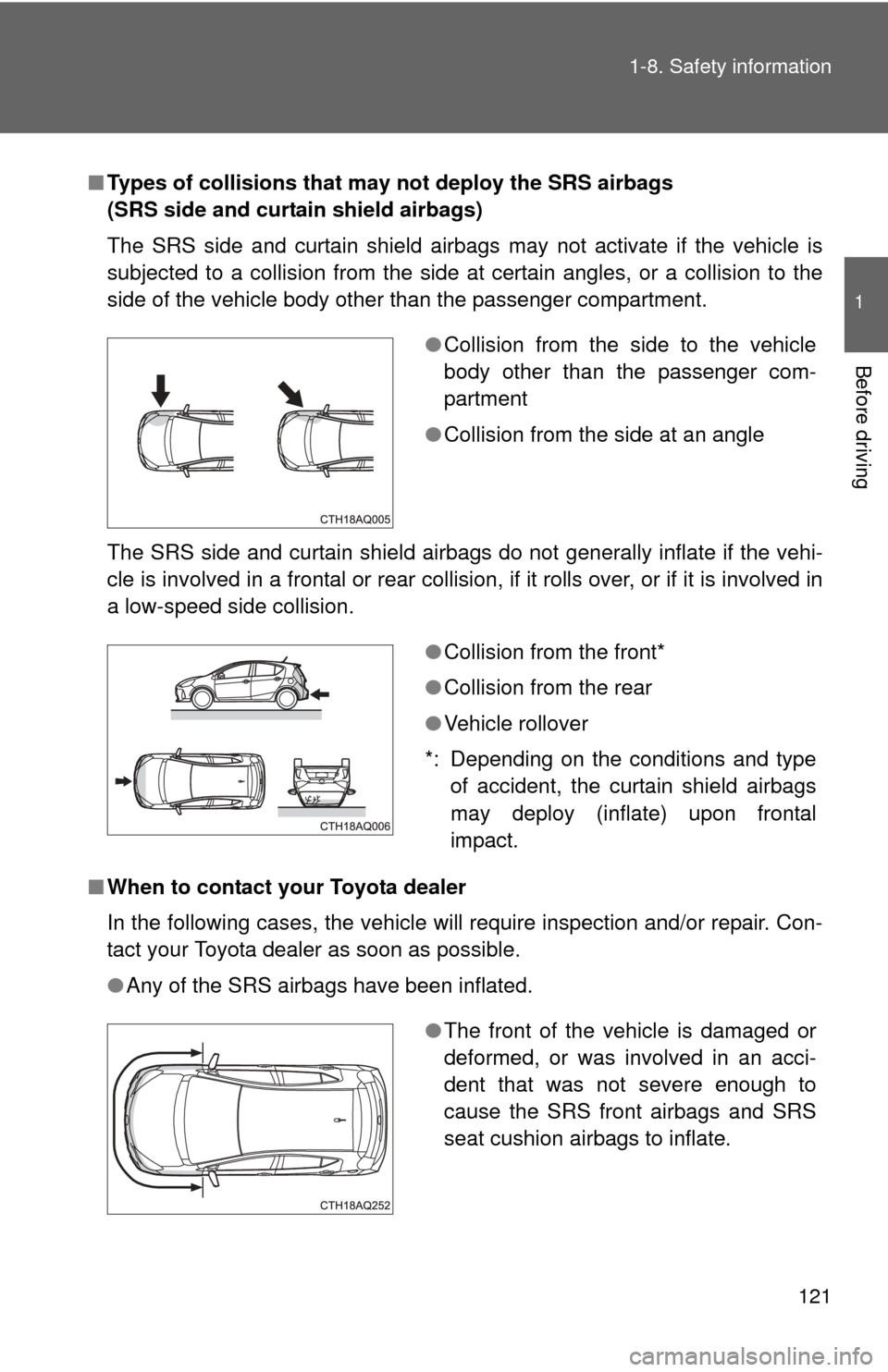Page 115 of 556
115
1
1-8. Safety information
Before driving
SRS airbags
The SRS airbags inflate when the vehicle is subjected to certain
types of severe impacts that may cause significant injury to the
occupants. They work together with the seat belts to help reduce the
risk of death or serious injury.
SRS front airbags
SRS driver airbag/front passenger airbag
Can help protect the head and ches t of the driver and front pas-
senger from impact with interior components.
SRS driver knee airbag
Can help provide driver protection.
Page 117 of 556
117
1-8. Safety information
1
Before driving
SRS airbag system components
Curtain shield airbags
SRS warning light and “AIR
BAG ON” and “AIR BAG
OFF” indicator lights
Side airbags
Side impact sensors (rear)
Front passenger’s seat
cushion airbag
Front passenger’s seat belt
buckle switch
Driver airbag
Driver’s seat belt buckle
switch Driver’s seat cushion airbag
Side impact sensors (front)
Seat belt pretensioners and
force limiters
Side impact sensors (front
door)
Driver’s knee airbag
Front passenger occupant
classification system (ECU
and sensors)
Airbag sensor assembly
Front impact sensors
Front passenger airbag
Page 119 of 556

119
1-8. Safety information
1
Before driving
●
Depending on the type of collision, it is possible that only the seat belt
pretensioners will activate.
● The SRS front airbags and seat cushion airbag for the front passenger
will not activate if there is no passenger sitting in the front passenger
seat. However, the SRS front airbags and seat cushion airbag for the
front passenger may deploy if luggage is put in the seat, even if the seat
is unoccupied.
● The SRS seat cushion airbags on the front seats will not operate if the
occupant is not wearing a seat belt.
■ SRS airbag deployment conditions (S RS side and curtain shield air-
bags)
● The SRS side and curtain shield airbags will deploy in the event of an
impact that exceeds the set threshold level (the level of force corre-
sponding to the impact force produced by an approximately 3300 lb.
[1500 kg] vehicle colliding with the vehicle cabin from a direction perpen-
dicular to the vehicle orientation at an approximate speed of 12 - 18 mph
[20 - 30 km/h]).
● The SRS curtain shield airbags may also deploy in the event of a severe
frontal collision.
■ Conditions under which the SRS airbags may deploy (inflate), other
than a collision
The SRS front airbags and SRS seat cushion airbags may also deploy if a
serious impact occurs to the underside of your vehicle. Some examples are
shown in the illustration.
●Hitting a curb, edge of pavement or
hard surface
● Falling into or jumping over a deep hole
● Landing hard or falling
Page 121 of 556

121
1-8. Safety information
1
Before driving
■
Types of collisions that may not deploy the SRS airbags
(SRS side and curtain shield airbags)
The SRS side and curtain shield airbags may not activate if the vehicle is
subjected to a collision from the side at certain angles, or a collision to the
side of the vehicle body other than the passenger compartment.
The SRS side and curtain shield airbags do not generally inflate if the vehi-
cle is involved in a frontal or rear collision, if it rolls over, or if it is involved in
a low-speed side collision.
■ When to contact your Toyota dealer
In the following cases, the vehicle will require inspection and/or repair. Con-
tact your Toyota dealer as soon as possible.
●Any of the SRS airbags have been inflated.
●Collision from the side to the vehicle
body other than the passenger com-
partment
● Collision from the side at an angle
●Collision from the front*
● Collision from the rear
● Vehicle rollover
*: Depending on the conditions and type of accident, the curtain shield airbags
may deploy (inflate) upon frontal
impact.
●The front of the vehicle is damaged or
deformed, or was involved in an acci-
dent that was not severe enough to
cause the SRS front airbags and SRS
seat cushion airbags to inflate.
Page 123 of 556

123
1-8. Safety information
1
Before driving
CAUTION
■
SRS airbag precautions
Observe the following precautions regarding the SRS airbags.
Failure to do so may cause death or serious injury.
●The driver and all passengers in the vehicle must wear their seat belts
properly.
The SRS airbags are supplemental devices to be used with the seat belts.
● The SRS driver airbag deploys with considerable force, and can cause
death or serious injury especially if the driver is very close to the airbag.
The National Highway Traffic Safety Administration (NHTSA) advises:
Since the risk zone for the driver’s airbag is the first 2 - 3 in. (50 - 75 mm)
of inflation, placing yourself 10 in. (250 mm) from your driver airbag pro-
vides you with a clear margin of safety. This distance is measured from the
center of the steering wheel to your breastbone. If you sit less than 10 in.
(250 mm) away now, you can change your driving position in several
ways:
• Move your seat to the rear as far as you can while still reaching the pedals comfortably.
• Slightly recline the back of the seat. Although vehicle designs vary, many drivers can achieve the 10 in. (250 mm) distance, even with the
driver seat all the way forward, simply by reclining the back of the seat
somewhat. If reclining the back of your seat makes it hard to see the
road, raise yourself by using a firm, non-slippery cushion, or raise the
seat if your vehicle has that feature.
• If your steering wheel is adjustable, tilt it downward. This points the air- bag toward your chest instead of your head and neck.
The seat should be adjusted as recommended by NHTSA above, while
still maintaining control of the foot pedals, steering wheel, and your view of
the instrument panel controls.
Page 125 of 556
125
1-8. Safety information
1
Before driving
CAUTION
■
SRS airbag precautions
●Do not allow a child to stand in front of
the SRS front passenger airbag unit or
sit on the knees of a front passenger.
● Do not allow the front seat occupants to
hold items on their knees.
● Do not lean against the door, the roof
side rail or the front, side and rear pil-
lars.
● Do not allow anyone to kneel on the
passenger seat toward the door or put
their head or hands outside the vehicle.
● Do not attach anything to or lean any-
thing against areas such as the dash-
board, steering wheel pad and lower
portion of the instrument panel.
These items can become projectiles
when the SRS driver, front passenger
and driver knee airbags deploy.
Page 127 of 556

127
1-8. Safety information
1
Before driving
CAUTION
■
SRS airbag precautions
●If breathing becomes difficult after the SRS airbags have deployed, open a
door or window to allow fresh air in, or leave the vehicle if it is safe to do
so. Wash off any residue as soon as possible to prevent skin irritation.
● If the areas where the SRS airbags are stored, such as the steering wheel
pad and front and rear pillar garnishes, are damaged or cracked, have
them replaced by your Toyota dealer.
● Do not place anything, such as a cushion, on the front passenger’s seat.
Doing so will disperse the passenger’s weight, which prevents the sensor
from detecting the passenger’s weight properly. As a result, the SRS front
airbags for the front passenger may not deploy in the event of a collision.
■ Modification and disposal of SRS airbag system components
Do not dispose of your vehicle or per form any of the following modifications
without consulting your Toyota dealer. The SRS airbags may malfunction or
deploy (inflate) accidentally, causing death or serious injury.
● Installation, removal, disassembly and repair of the SRS airbags.
● Repairs, modifications, removal or replacement of the steering wheel,
instrument panel, dashboard, seats or seat upholstery, front, side and rear
pillars or roof side rails.
● Repairs or modifications of the front fender, front bumper, or side of the
occupant compartment.
● Installation of snow plows, winches, etc. to the front grille (bull bars or kan-
garoo bar etc.).
● Modifications to the vehicle’s suspension system.
● Installation of electronic devices such as mobile two-way radios and CD
players.
● Modifications to your vehicle for a person with a physical disability.
Page 129 of 556

129
1-8. Safety information
1
Before driving
Condition and operation in the front passenger occupant classification system
■
Adult*1
■Child restraint system with infant*5
Indicator/
warning light “AIR BAG ON” and “AIR BAG OFF”
indicator lights “AIR BAG
ON”
SRS warning light Off
Seat belt reminder light Off*2
or
flashing
*3
Devices Front passenger airbag
Activated
Side airbag on the front passenger seat
Curtain shield airbag in the front passenger side
Seat cushion airbag in the front passenger side Activated*2
or
deactivated
*3
Front passenger’s seat belt pretensioner Activated
Indicator/
warning light “AIR BAG ON” and “AIR BAG OFF”
indicator lights “AIR BAG
OFF”
*6
SRS warning light Off
Seat belt reminder light Off
*2
or
flashing
*3
Devices Front passenger airbag Deactivated
Side airbag on the front passenger seat Activated
Curtain shield airbag in the front passenger
side
Seat cushion airbag in the front passenger side Deactivated
Front passenger’s seat belt pretensioner Activated